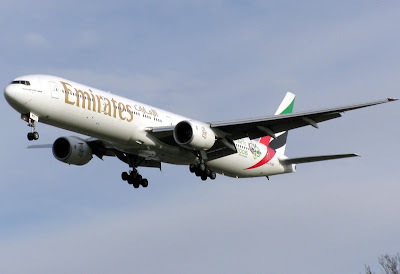In the 1970s, Boeing unveiled new models: the twin-engine 757 to replace the venerable 727, the twin-engine 767 to challenge the Airbus A300, and a trijet 777 concept to compete with the DC-10 and the Lockheed L-1011 TriStar. Based on a re-winged 767 design, the 275 seat 777 was to be offered in two variants: a 2,700 nautical miles (5,000 km) transcontinental and an 4,320 nmi (8,000 km) intercontinental.
The twinjets were a big success, due in part to the 1980s ETOPS regulations. However the trijet 777 was cancelled (much like the trijet concept of the Boeing 757) in part because of the complexities of trijet design and the absence of a 40,000 lbf (178 kN) engine. The cancellation left Boeing with a big size and range gap in its product line between the 767-300ER and the 747-400. The DC-10 and L-1011, which entered service in early 1970s, were also ripe for replacement. In the meantime, Airbus developed the A340 to fulfill that requirement and compete with Boeing.
In the mid 1980s Boeing produced proposals for an enlarged 767, dubbed 767-X. It had a longer fuselage and larger wings than the existing 767, and seated about 340 passengers with a maximum range of 7,300 nautical miles (13,500 km). The airlines were unimpressed with the 767-X: they wanted short to intercontinental range capability, a bigger cabin cross section, a fully flexible cabin configuration and an operating cost lower than any 767 stretch. By 1988 Boeing realised that the only answer was a new design: the 777 twinjet.
The design phase of the 777 differed from that of previous Boeing jetliners. For the first time, eight major airlines had a role in the development of the plane. The airlines consulted were United Airlines, American Airlines, Delta Air Lines, ANA, British Airways, JAL, Qantas, and Cathay Pacific. (As of May 2007, Qantas is the only carrier, of the major airlines consulted, who has yet to order the 777.) The "Working Together" philosophy, as Boeing called it, meant that the 777 was their most customer oriented aircraft yet.
In October 1990, United Airlines became the 777's launch customer when it placed an order for 34 of the -200 variant with options on a further 34. Production of the first aircraft began in January 1993 at Boeing's Everett plant near Seattle.
The 777 included substantial international content, to be exceeded only by the 787. International contributors included Mitsubishi Heavy Industries and Kawasaki Heavy Industries (fuselage panels), Fuji Heavy Industries, Ltd. (center wing section), Hawker De Havilland (elevators), ASTA (rudder) and Ilyushin (jointly designed overhead baggage compartment).
The 777 first flew on June 14, 1994 piloted by 777 Chief Test Pilot John E. Cashman. The aircraft would later undergo a flight test program more extensive than any other Boeing model. The development, testing, and delivery of the 777 was the subject of the documentary series, "21st Century Jet: The Building of the 777." The FAA awarded full 180 minute ETOPS clearance ("ETOPS-180") for PW4074 777-200s on May 30, 1995. The 777 was the first aircraft to carry an ETOPS-180 rating at its entry into service.
Due to rising fuel costs, airlines began looking at the Boeing 777 as a fuel efficient alternative compared to other widebody jets. With modern engines having extremely low failure rates (as seen in the ETOPS certification of most twinjets) and increased power output, four engines are no longer necessary except for very large aircraft, such as the Airbus A380 or Boeing 747.
Singapore Airlines is the largest operator of the Boeing 777 family with 67 in service, of which 46 are of the 777-200ER variant, 12 are 777-300s and 9 are 777-300ERs. Another 10 777-300ERs are on firm order, with 13 more on option.
As of May 2007, 50 customers have placed 988 orders for 777s.
The Boeing 777 is an American long-range wide-body twin-engined airliner built by Boeing's Commercial Airplanes division. It can carry between 301 and 368 passengers in a three-class configuration and has a range from 5,210 to 9,420 nautical miles (9,650 to 17,450 km). Distinguishing features of the 777 include the set of six wheels on each main landing gear, its perfectly circular fuselage cross section, the pronounced "neck" aft of the cockpit, and the blade-like rear tailcone.
The 777 was the first commercial aircraft to be designed entirely on computer. No mock-ups were ever produced; everything was created on a 3D CAD software system known as CATIA. This allowed a virtual 777 to be assembled in simulation, to check for interferences and to verify proper fit of the many thousands of parts before costly physical prototypes were manufactured.
Direct market competitors to the 777 are the Airbus A330-300, A340 and some models of the proposed A350 XWB. The 777 may eventually be replaced by a new product family, the Y3, which would draw upon 787 technologies. The Y3 may also replace the 747 series.
Source: Wikipedia
July 10, 2007
Boeing 777
Labels: Aircraft List
Subscribe to:
Post Comments (Atom)






No comments:
Post a Comment